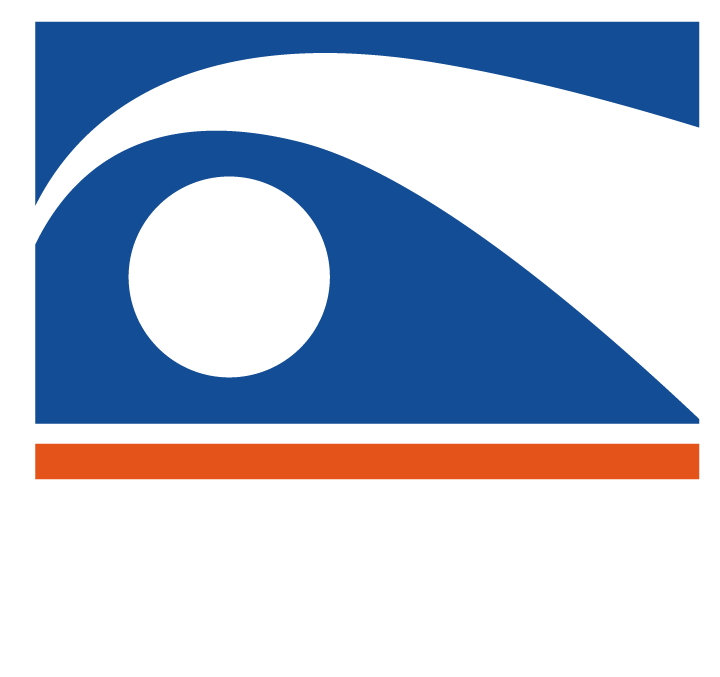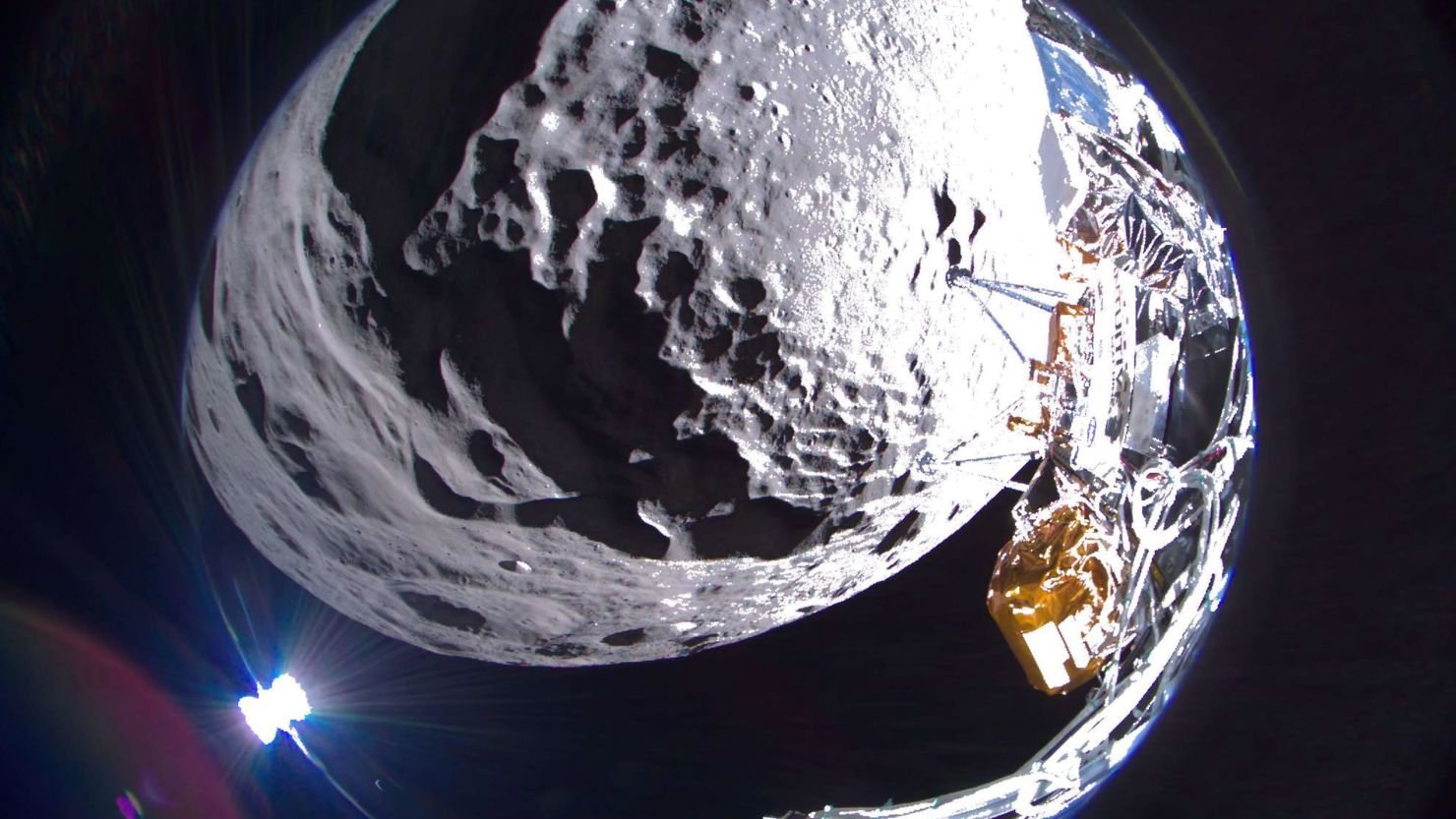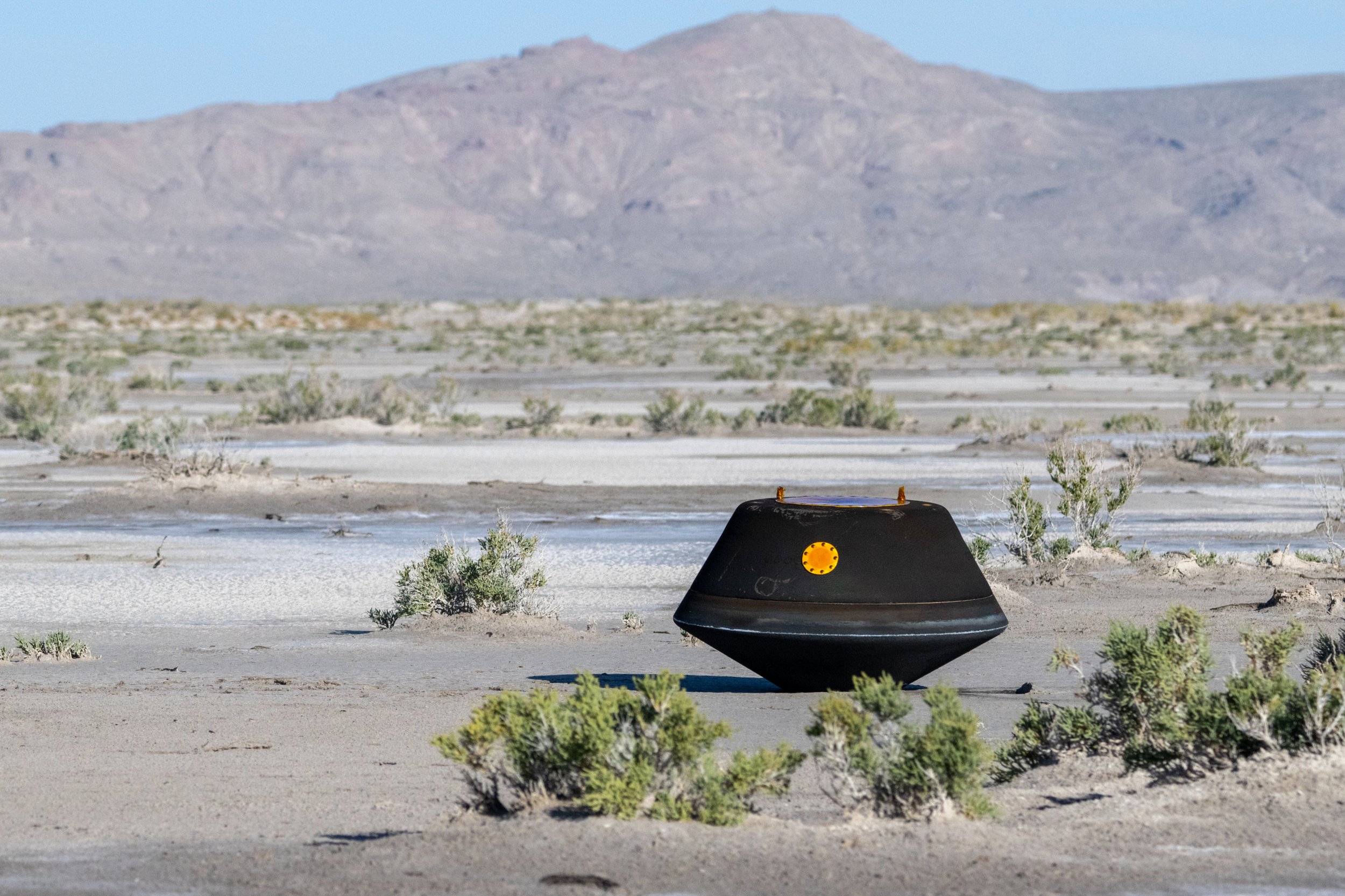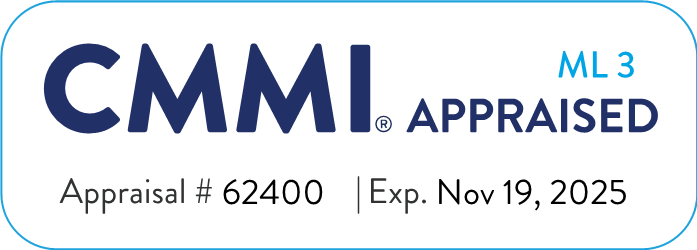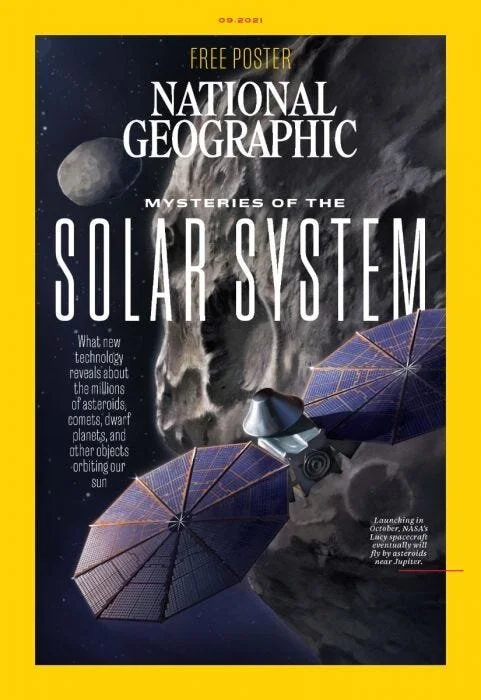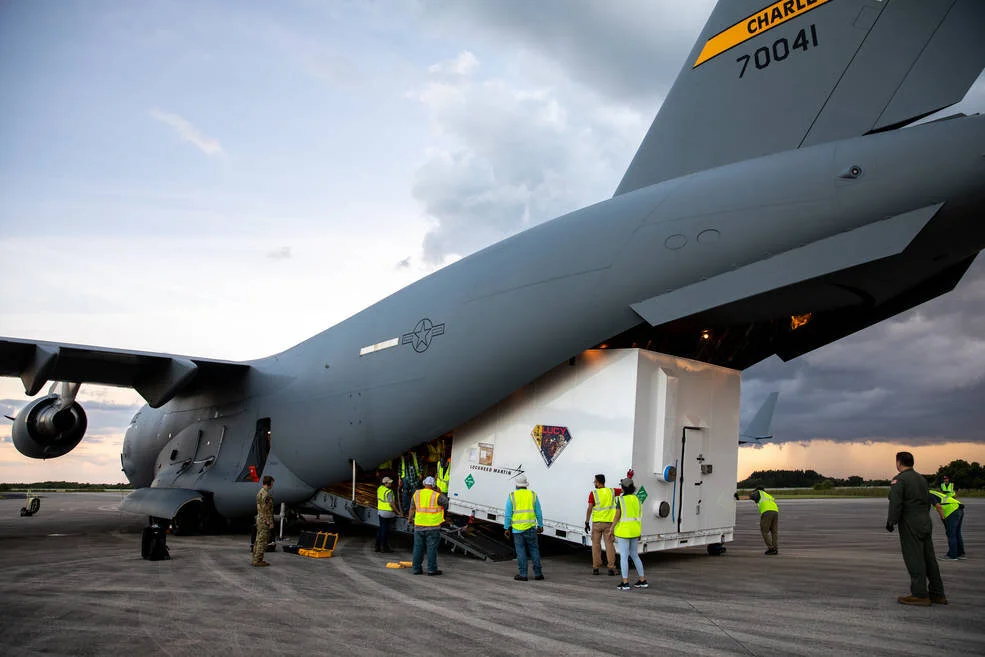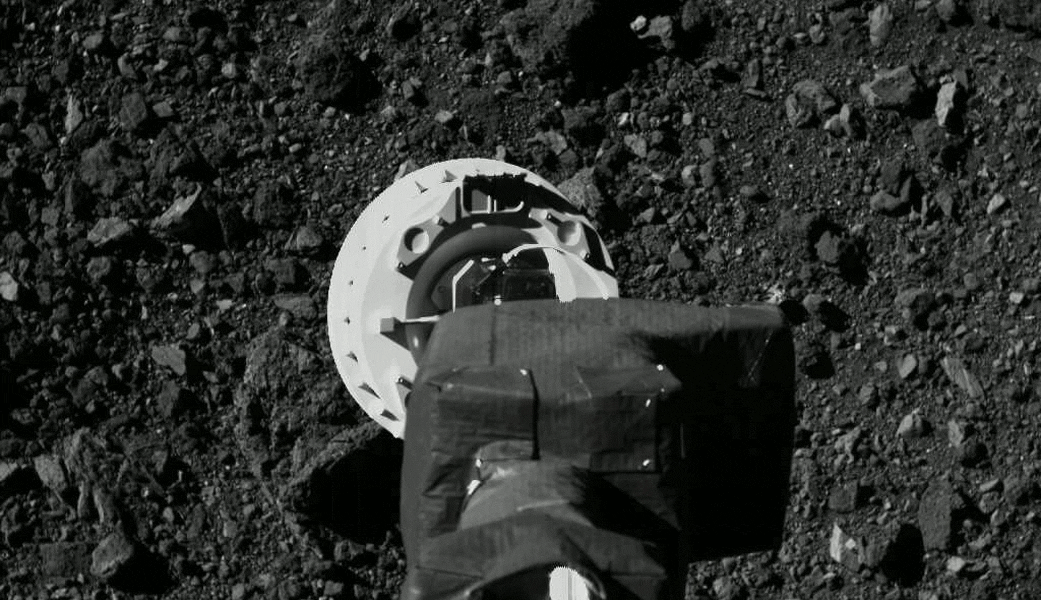February 23, 2024
Odie has landed! Yesterday, Intuitive Machines’ IM-1 Odysseus (“Odie”) lunar lander touched down near the South Pole of the Moon, after an exciting week of operations following its launch from Earth on February 15. Several members of the Space Navigation and Flight Dynamics team at KinetX provided IM-1 navigation support remotely and on-site at Intuitive Machines HQ in Houston. More information about KinetX’s orbit determination (OD) and optical navigation (OpNav) support for IM-1 can be found in the press release here. Congratulations to the Intuitive Machines and KinetX teams on an incredible achievement! Ad Astra!
February 15, 2024
Early this morning, members of the Space Navigation and Flight Dynamics team at KinetX attended and supported the launch of Intuitive Machines’ IM-1 Odysseus NOVA-C lunar lander! The Odysseus lander was injected into a translunar trajectory by a SpaceX Falcon 9 launch vehicle, and is currently on its journey to the Moon. The KinetX team is providing orbit determination and optical navigation support for the mission, with several members working on-site at Intuitive Machines’ missions operations center. KinetX is excited to be supporting this historic mission, as it attempts to be the first U.S. vehicle to successfully land on the Moon since the last Apollo lander in 1972. More information about the launch can be found here. Go Odysseus (Odie)!
February 7, 2024
This week, several members of the Space Navigation and Flight Dynamics team at KinetX attended the 46th Rocky Mountain AAS GN&C Conference in Breckenridge, CO to present papers about recent navigation activities from the Lucy mission’s Dinkinesh flyby and the OSIRIS-REx mission’s asteroid sample return. In total, the KinetX team presented 7 papers as first authors, and convened 2 technical sessions with employees serving as national chairs. KinetX is excited to have been a sponsor for the conference, exhibiting an informational booth about our company and projects. An online conference program can be found here.
February 4, 2024
Lucy’s trajectory to the Jupiter L4 Trojan asteroids, with this week’s DSMs labeled.
Image Credit: NASA/GSFC/SWRI
Over the past week, the Lucy spacecraft performed two deep space maneuvers (DSMs) using its main propulsion engine, adjusting its trajectory to encounter the Jupiter L4 Trojan asteroids in 2027-2028. These maneuvers occurred on January 31 and February 3, and were the first time that Lucy’s main engine was operated in-flight. The second maneuver on February 3 is the largest planned DSM of the spacecraft’s 12-year mission, requiring the main engine to operate for over 36 minutes. KinetX continues to provide navigation and flight dynamics support for the Lucy mission, and was integral in designing the maneuver parameters for this large trajectory adjustment. More information about the DSM maneuvers can be found here. Go Lucy!
January 5, 2024
Video of OSIRIS-APEX trajectory to Apophis.
Video Credit: NASA/GSFC/LM/KinetX
The OSIRIS-REx spacecraft has officially transitioned to its extended mission, renamed OSIRIS-Apophis Explorer (OSIRIS-APEX), as it embarks on its journey to rendezvous with and explore the Apophis asteroid in 2029! The Space Navigation and Flight Dynamics team at KinetX continues to provide navigation and flight dynamics support for the OSIRIS-APEX mission, and has been monitoring the spacecraft’s trajectory after it recently flew 0.27 AU closer to the Sun than it was originally designed. The spacecraft performed well through its closest encounter with the Sun, and continues to operate normally. More information about the OSIRIS-APEX mission can be found here, and more information about the solar closest approach can be found here.
November 7, 2023
Today, the Lucy mission announced that the secondary asteroid in the Dinkinesh system is in fact a contact binary asteroid itself! This was discovered using images before and after Lucy’s closest approach to the Dinkinesh system that were downlinked from the spacecraft over the few days following the flyby. This is the first observation of a contact binary asteroid orbiting another asteroid! The Lucy flight dynamics team at KinetX continues to analyze the trajectory of the spacecraft and system throughout closest approach to refine the relative position of the spacecraft. More information about the discovery can be found here.
November 2, 2023
Yesterday, the Lucy spacecraft successfully performed its close flyby of asteroid Dinkinesh, which in fact turns out to be not one but two asteroids! The images acquired at closest approach to the asteroid system has revealed that Dinkinesh is made up of one larger asteroid and one smaller one in orbit around the primary body. The Lucy flight dynamics team at KinetX successfully navigated the spacecraft through its closest approach transition to its terminal tracking phase, and continues to track and reconstruct the trajectory during and beyond the encounter. More information about the encounter and discovery can be found here. Go Lucy!
October 24, 2023
The Lucy flight dynamics team at KinetX continues to perform critical navigation activities in support of the NASA Lucy mission’s upcoming flyby of asteroid Dinkinesh on November 1, 2023. The team has been processing optical navigation images of asteroid Dinkinesh over the last several weeks, which have informed spacecraft orbit determination and maneuver design en route to the flyby target. The team performed a small trajectory correction maneuver (TCM) on September 29 which retargeted the trajectory to pass approximately 425 km away from Dinkinesh during its closest approach. More information about the navigation and spacecraft events leading up to the Dinkinesh encounter can be found here and here.
September 30, 2023
Members of KinetX’s OSIRIS-REx Navigation Team at the Sample Return Celebration.
Today, several members of KinetX’s OSIRIS-REx navigation team attended an OSIRIS-REx mission-wide team ceremony at Space Center Houston, in celebration of this week’s successful asteroid sample return! The weekend full of events was a great opportunity for KinetX staff members to reconnect with colleagues from other institutions and from all stages of mission development. KinetX is extremely proud of all of its employees who supported OSIRIS-REx navigation system development and operations, and congratulates the entire OSIRIS-REx mission team on its record-setting asteroid sample return!
September 24, 2023
After over 12 years of extensive planning, testing and operations the OSIRIS-REx mission team successfully returned pristine samples of asteroid Bennu to Earth! The OSIRIS-REx spacecraft safely deployed the sample return capsule (SRC) containing samples of asteroid Bennu early this morning, after which the primary spacecraft successfully performed a divert maneuver to avoid re-entering the Earth’s atmosphere. The SRC on the other hand, successfully re-entered the atmosphere along its intended path, and after a successful parachute deployment, the capsule safely landed within the Utah Test and Training Range (UTTR), where it was assessed and further transported by helicopter to an interim clean room facility nearby. The sample will soon be transported to NASA’s Johnson Space Center, where it will be stored and analyzed. The OSIRIS-REx navigation team at KinetX has provided flight dynamics services for OSIRIS-REx throughout the entire mission profile, and is extremely proud of the mission’s success! More information about today’s sample return activities can be found here.
September 17, 2023
Today, KinetX’s OSIRIS-REx navigation team successfully performed trajectory correction maneuver #12 (TCM-12), which successfully retargeted the OSIRIS-REx spacecraft to its final trajectory en route for Earth re-entry. The next major milestone will be the sample return capsule (SRC) release from the primary spacecraft and Earth atmospheric entry of the capsule on September 24. More information about the OSIRIS-REx navigation timeline can be found in the news post below.
July 25, 2023
Timeline of Events for OSIRIS-REx Sample Return maneuvers and release. Image Credit: Lockheed-Martin/GSFC/KinetX
Tomorrow, the OSIRIS-REx mission will perform a trajectory correction maneuver (TCM-10) in preparation for its asteroid sample return later this fall. The primary goal of TCM-10 is to reduce the spacecraft’s closest approach altitude above the Earth’s surface from approximately 2300 km (1430 miles) to approximately 210 km (130 miles). This is made possible by a reduction in the predicted uncertainties of the spacecraft trajectory as the spacecraft gets closer to Earth. The spacecraft will execute TCM-10 by firing 4 of its attitude control thrusters for 64 seconds in order to adjust the spacecraft's velocity by 57 cm/s (1.28 mph). TCM-10 is necessary because it helps reduce the fuel cost and improves the delivery performance of the final Earth targeting maneuvers, which are planned for the weeks just before SRC Release. TCM-10 will be executed on July 26, which marks 60 days until the release of the Sample Return Capsule, which is set to land in the Utah desert on September 24, 2023.
A full timeline of navigation-related events, including nominal and contigency maneuver opportunities before and after sample return (SRC release) are provided in the table below.
| Date | Event |
|---|---|
| 17-Jul-23 | TCM-10/TCM-10a Final Design Data Cutoff |
| 25-Jul-23 | OD361 Delivery |
| 26-Jul-23 | TCM-10 Execution |
| 28-Aug-23 | TCM-11 Preliminary Design Data Cutoff |
| 8-Sep-23 | TCM-11 Final Design Data Cutoff |
| 10-Sep-23 | TCM-11 Execution |
| 11-Sep-23 | TCM-12 Preliminary Design Data Cutoff |
| 12-Sep-23 | Begin Daily Orbit Determination Solutions and Deliveries |
| 15-Sep-23 | TCM-12 Final Design Data Cutoff |
| 17-Sep-23 | TCM-12 Execution |
| 21-Sep-23 | Contingency TCM-13 Final Design Data Cutoff |
| 23-Sep-23 | Spacecraft moves to SRC Release attitude |
| 23-Sep-23 | Contingency TCM-13 Execution |
| 23-Sep-23 | Conjunction Avoidance Maneuver Go/No-Go Decision |
| 23-Sep-23 | Contingency Conjunction Avoidance Maneuver Execution |
| 24-Sep-23 | SRC Release and Earth Entry |
| 24-Sep-23 | Earth Divert Maneuver Execution |
| 9-Oct-23 | TCM-14 Preliminary Design Data Cutoff |
| 16-Oct-23 | TCM-14 Final Design Data Cutoff |
| 23-Oct-23 | TCM-14 Execution |
December 2, 2022
LunaH-Map’s star tracker image of the constellation Auriga in false color and increased contrast, with markers indicating the stars chosen by the spacecraft’s autonomous navigation software for attitude determination. Green crosses indicate the star locations predicted by the software and red crosses indicate their actual observed locations in the image. Image Credit: NASA/ASU/KinetX
Today, KinetX successfully exercised its autonomous optical navigation software suite on-board NASA's LunaH-Map spacecraft, using stellar and planetary images acquired by the spacecraft's star tracker camera. The test demonstrated that the navigation process could autonomously correct raw images on-board, estimate the inertial camera orientation using visible stars, compute the astrometric centers of planetary targets in the field, and compute offsets relative to the spacecraft state. Each of these measurements are critical to performing autonomous navigation using on-board images, without intervention from ground assets. This demonstration verifies KinetX' ability to develop and operate flight optical navigation software on-board interplanetary spacecraft and represents a major achievement in KinetX' pursuit to extend the capabilities of autonomous deep space navigation systems.
More details about the technology demonstration can be found on NASA’s blog post here.
November 30, 2022
KinetX created and maintains a Quality Management System (QMS) that meets the latest AS9100 (which includes ISO 9001) standard for Aerospace quality, and in addition satisfies the latest CMMI Level 3 maturity level requirements. In November 2022 KinetX successfully passed their annual AS9100D surveillance audit to maintain their AS9100D certification. In November 2022 KinetX also successfully completed their CMMI version 2 appraisal at a Level 3 maturity level, which is performed every 3 years. KinetX’s ability to obtain and sustain these quality standards demonstrates our commitment to produce quality products/services that are delivered on-time, understand customer needs/concerns, implement corrective actions when necessary, achieve high levels of customer satisfaction, and execute projects in an efficient cost-effective manner.
April 29, 2022
KinetX is thrilled to announce that two of our active spacecraft were funded for extended missions this week! The OSIRIS-REx and New Horizons missions were both selected to continue exploration of the solar system with additional support spanning coming years. New Horizons, which we have been navigating since 2006, will continue to explore the Kuiper Belt while collecting multi-disciplinary data in support of planetary science, heliophysics and astrophysics research. The OSIRIS-REx extended mission will carry a new name after the asteroid sample is dropped off at Earth. OSIRIS-APEX will rendezvous with and characterize Apophis immediately after the asteroid’s close approach with Earth in 2029. Not only will the KinetX team navigate this challenging mission around an asteroid even smaller than Bennu, but two of our staff members will also be scientific co-investigators on the mission. We look forward to working with our mission partners for years to come. Information about each of the extended missions are available here and cited below:
OSIRIS-APEX (Principal Investigator: Dr. Daniella DellaGiustina, University of Arizona): The Origins, Spectral Interpretation, Resource Identification, Security-Regolith Explorer (OSIRIS-REx) mission is currently on its way back to Earth to deliver the samples of asteroid Bennu that it collected in 2020. Dante Lauretta, OSIRIS-REx PI, will remain in place for the primary mission, while DellaGiustina begins her role as the newly named PI for OSIRIS-APophis EXplorer (OSIRIS-APEX). With a new name to reflect the extended mission’s new goals, the OSIRIS-APEX team will redirect the spacecraft to encounter Apophis, an asteroid roughly 1,200 feet (roughly 370 meters) in diameter that will come within 20,000 miles (32,000 kilometers) of Earth in 2029. OSIRIS-APEX will enter orbit around Apophis soon after the asteroid’s Earth flyby, providing an unprecedented close-up look at this S-type asteroid. It plans to study changes in the asteroid caused by its close flyby of Earth and use the spacecraft’s gas thrusters to attempt to dislodge and study the dust and small rocks on and below Apophis’ surface.
New Horizons (Principal Investigator: Dr. Alan Stern, SwRI): New Horizons flew past Pluto in 2015 and the Kuiper belt object (KBO) Arrokoth in 2019. In its second extended mission, New Horizons will continue to explore the distant solar system out to 63 astronomical units (AU) from Earth. The New Horizons spacecraft can potentially conduct multi-disciplinary observations of relevance to the solar system and NASA’s Heliophysics and Astrophysics Divisions. Additional details regarding New Horizons’ science plan will be provided at a later date.
April 8, 2022
This week, KinetX leadership supported the 37th Space Symposium in Colorado Springs, CO and sponsored a booth in collaboration with other Arizona-based space companies. We are inspired by the commercial and international push for deep space, and excited to provide our decades-long interplanetary navigation and systems engineering expertise to current and future missions. Click here to contact us and collaborate on your mission!
February 7, 2022
Last week, KinetX SNAFD attended and presented several papers at the AAS GNC Conference in Breckenridge, CO. The presentations largely focused on OSIRIS-REx navigations operations at Bennu and related analyses, including a comparison of navigation results compared to pre-launch predictions. The presentations can be found in the conference program here.
January 7, 2022
This week, KinetX SNAFD attended and presented several technical papers at the AIAA SciTech 2022 Conference in San Diego, CA. The presentations predominantly covered technical results from navigation of the OSIRIS-REx mission's proximity operations, Touch-and-Go (TAG) and post-TAG reconnaissance campaigns, as well as optical navigation development efforts for the Lucy mission. The event also served as a great opportunity for KinetX employees to network in-person with several partners on current and future missions.
December 15, 2021
This week, KinetX SNAFD attended the AGU Fall 2021 Meeting in New Orleans to represent NASA’s OSIRIS-REx mission and present two posters on our analysis of particle ejections from asteroid Bennu’s surface and image reconstruction of the sample mass loss during the mission’s sample stow campaign. Coralie Adam, KinetX’ TAG navigation lead, also presented an overview of the mission’s proximity operations and sampling event on the “hyperwall” at NASA’s Planetary Science booth. Both posters as well as the mission overview highlighted the team’s advances in particle tracking, trajectory estimation and 3D visualization. The interactive posters can be viewed using the links below:
October 16, 2021
NASA’s Lucy spacecraft successfully lifted off aboard an Atlas V 401 from Space Launch Complex 41 (SLC-41) at Cape Canaveral Space Force Station today, October 16, 2021 at 5:34 am EDT, kicking off its journey to explore several Jupiter trojan asteroids. The Space Navigation and Flight Dynamics (SNAFD) practice of KinetX serves as the flight dynamics and navigation team for the Lucy mission. The KinetX team completed launch navigation operations with a successful determination of Lucy’s post-launch trajectory. The KinetX navigation team will continue monitoring Lucy’s trajectory and determine whether a trajectory correction maneuver (TCM) will be required to maintain its desired course in the coming months. The KinetX navigation team will also begin assisting with calibration of several vehicle components including the thrusters and optical navigation cameras, and begin initial flight preparations for the mission’s next major milestone – Lucy’s first Earth gravity assist in October 2022. More information about the Lucy launch activities can be found here.
August 24, 2021
The Lucy mission is on the September 2021 cover of National Geographic! Lucy is one of several missions (including KinetX’ OSIRIS-REx mission to Bennu) highlighted in the “Mysteries of the Solar System” cover article, which describes the recent accomplishments and plans for several missions to explore the origins and evolution of our Solar System. In addition to the cover article, Nat Geo also released a podcast about Lucy and its primary scientific objectives which can be streamed here.
August 3, 2021
NASA’s Lucy spacecraft was successfully delivered from its integration facility at Lockheed Martin in Littleton, CO to Kennedy Space Center for final testing and integration onto its Atlas V 401 launch vehicle today. The final I&T campaign will prepare the Lucy spacecraft and Atlas V launch vehicle for its scheduled launch on October 16. KinetX will be supporting launch operations and is excited to serve as the navigation team for this exciting mission to the Jupiter trojan asteroids! More information about the spacecraft delivery and preparations for launch can be found here.
July 14, 2021
Today, the LunaH-Map CubeSat for which KinetX is providing mission design and navigation services was shipped from its integration facility at Arizona State University to NASA’s Kennedy Space Center for final integration onto the Space Launch System (SLS) launch vehicle. LunaH-Map is one of several CubeSats being launched and deployed as secondary payloads on the Artemis-1 mission. More information about the LunaH-Map delivery and integration onto SLS can be found here and here.
June 8, 2021
KinetX is pleased to announce its sponsorship of the American Physics Society (APS) Conference for Undergraduate Women in Physics (CUWiP) scheduled for Jan. 21-23, 2022 at the University of Arizona. This conference is aimed at helping undergraduate women continue in physics by connecting them with a community of women in the field with whom they can share experiences, advice, and ideas. More information regarding the conference can be found here.
June 2, 2021
KinetX will provide flight dynamics and navigation services supporting Goddard Space Flight Center on the DAVINCI+ mission; one of two missions selected by NASA today to explore and unlock the mysteries of our neighbor planet, Venus. The primary objective of the mission is to understand the composition, origin, and evolution of Venus’ atmosphere, and to further our understanding of how once habitable planets change over time. Click here to learn more about the mission.
May 17, 2021
KinetX Aerospace management and Board of Directors is pleased to announce that Dr. Alan Stern has agreed to serve on the KinetX Board of Directors in 2021. We are proud to have Dr. Stern as an integral part of the KinetX vision team that will guide our corporate course for 2021 and beyond.
May 10, 2021
The OSIRIS-REx spacecraft performed its Asteroid Departure Manuever (ADM) today, marking the beginning of its ~2.5 year journey back to Earth. The KinetX Space Navigation and Flight Dynamics team responsible for navigating the OSIRIS-REx spacecraft designed the maneuver, targeting an Earth return date of Sept. 24, 2023. More information is available here.
Image Credit: NASA/GSFC/UA
April 17, 2021
Today, the New Horizons spacecraft achieved a significant milestone, officially surpassing 50 AU (astronominal units) in distance from the Sun. The KinetX Space Navigation and Flight Dynamics team continues to navigate the spacecraft by monitoring tracking data to reconstruct the spacecraft’s trajectory in the past, and predict its trajectory into the future. More information can be found here.
Image Credit: NASA/JHUAPL/SwRI
April 7, 2021
Image Credit: NASA/GSFC/UA
The OSIRIS-REx spacecraft performed a flyby of the TAG sample site today, marking its last closest approach to asteroid Bennu before its planned departure from proximity operations scheduled for May 2021. This flyby gave the mission team an opportunity to acquire images and data of the sample site after the TAG collection event on Oct. 20, 2020. The images and data will allow the team to characterize the impact of the sample collection event on the surface, leading to further understanding of the surface and sample properties. More information can be found here.
October 21-23, 2020
Image Credit: NASA/GSFC/UA
Two days after the Touch-and-Go Sample Acquisition Mechanism (TAGSAM) touched down on Bennu’s surface, the team back on Earth had various concerns regarding the sampling attempt. The TAGSAM arm was repositioned by the team for inspection. The Mylar flap of the sampler head was jammed with pieces of regolith, resulting in dust and rock particles leaking out. The team decided to cancel the planned mass measurement and turn the spacecraft toward Earth for clearer communication, and to keep the arm still to avoid agitating or losing the sample. The main focus became to get the sample stowed in the capsule promptly. The team worked hard on building software to track the motions and distances of each particle and to estimate the mass of the portion of sample that had already been lost. Other teams worked to compute how much sample remained in the sample head. The team concluded with confidence that they had collected far more than the mission requirement of 60 grams and successfully stowed the sample a few days later.
October 20, 2020
Image Credit: NASA/GSFC/UA
On October 20, 2020, the OSIRIS-REx Spacecraft touched down on the surface of the asteroid Bennu to collect a sample, this long-awaited maneuver is known as Touch-and-Go (TAG). The sampling head of the spacecraft touched Bennu’s surface for approximately 6 seconds, where nitrogen gas was fired to agitate the sample into the head, and then the spacecraft backed away from the surface. The spacecraft’s onboard camera, SamCam, took consecutive images as the TAG event occurred. The images showed the descent of the spacecraft, the contact, and then the backaway, in which there was debris floating due to the impact. The sampling head sank nearly 50 cm into the surface by the time the retro-thrusters reversed the spacecraft's motion. The spacecraft touched down less than 3 feet from the center of the planned target. The successful sample collection was the culmination of years of analysis, planning, and data processing by the KinetX Navigation Team. When the sample is returned to Earth in 2023, scientists will be able to further understand Bennu and it's history.
August 11, 2020
Image Credit: NASA/GSFC/UA
On August 11th, 2020, the OSIRIS-REx spacecraft performed the Matchpoint Rehearsal, conducting three of the four maneuvers for the sampling sequence, including the orbit departure burn, the “checkpoint” burn, and the “matchpoint” burn. This matchpoint maneuver occurred approximately 50 meters from Bennu’s surface, putting the spacecraft on a trajectory that matches the rotation of Bennu in order to descend toward the targeted spot for TAG. The rehearsal was successfully completed in four hours and the spacecraft returned to its orbit around Bennu.
May 27, 2020
Image Credit: NASA/GSFC/UA
The OSIRIS-REx spacecraft performed a low-altitude flyby over the backup sample collection site, Osprey, to take observations of the site. A main goal of the flyby was to take high resolution images of Bennu’s surface and to allow the Natural Feature Tracking (NFT) image catalog to document the features on the asteroid's surface. Several other instruments on the spacecraft took observations of the sample site. The spacecraft successfully completed the flyby and returned to its orbit around Bennu. This activity will allow the KinetX navigation team to assess the site for hazards that could affect the spacecraft’s TAG attempt, if the team chooses to sample the backup site.
April 14, 2020
Image Credit: NASA/GSFC/UA
The Checkpoint Rehearsal was an opportunity for the team to take the sample collection system for a test run, and the closest the spacecraft had been to Bennu’s surface. The rehearsal allowed the team to practice navigating the spacecraft through the orbit departure and “Checkpoint” maneuvers. The team was able to make sure that the imaging, navigation and ranging systems were operating as planned, and were also able to confirm that the Natural Feature Tracking system was precisely updating the velocity and position of the spacecraft relative to Bennu as it gets closer to the surface. The spacecraft successfully completed the maneuver and returned to its orbit around Bennu.
March 3, 2020
Image Credit: NASA/GSFC/UA
During the Nightingale flyby, the OSIRIS-REx spacecraft got the closest it’s been to Bennu and was able to take observations of the surface. This sample site is the spacecraft's primary site for sampling and is located in the northern hemisphere of Bennu, in a crater. The main goal of the flyby was to take high resolution images of Bennu’s surface with the PolyCam instrument. Other instruments onboard took observations of the sampling site, including the OSIRIS-REx Thermal Emissions Spectrometer, the OSIRIS-REx Visual and InfraRed Spectrometer, the OSIRIS-REx Laser Altimeter, and the MapCam color imager. This activity will allow the KinetX navigation team to assess the site for hazards that could affect the spacecraft’s TAG attempt.
February 11, 2020
Image Credit: NASA/GSFC/UA
The OSIRIS-REx Spacecraft completed a 0.4-mile flyover of Osprey, the secondary sample collection site of Bennu. Preliminary telemetry determined that the Laser Altimeter was not operating as the team expected during the event. This instrument was meant to provide ranging data to the PolyCam onboard the spacecraft and would allow the camera to focus while collecting observations of the surface.
January 21, 2020
Image Credit: NASA/GSFC/UA
The OSIRIS-REx Spacecraft completed a 0.4-mile flyover of site Nightingale, which is OSIRIS-REx’s primary sample collection site, located in a crater in the northern hemisphere of Bennu. The spacecraft left its orbit and flew an 11-hour transit over Bennu, while aiming the instruments toward the site before returning to orbit. The main goal of this flyover was to collect imagery to document the sample collection site’s surface and its features.
January 19, 2019
Image Credit: NASA/GSFC/UA/Lauretta & Hergenrother et al. Science 10.1126
Soon after the OSIRIS-REx spacecraft arrived at Bennu and entered orbit, there was an unexpected finding by the science team today, showing that Bennu had particles ejecting from its surface into space. The particles were seen in images taken by the navigation camera on January 6th, 2019. The team initially thought the particles were distant stars behind Bennu, however, with further investigation the team concluded that Bennu was ejecting particles from its surface. The event created an opportunity for the KinetX Optical Navigation team to develop new tools to determine the trajectory of these released particles, which fed into analysis by both navigators and scientists.
December 31, 2018
The OSIRIS-REx spacecraft entered into orbit around the asteroid Bennu on December 31, 2018. Bennu became the smallest asteroid to ever have a spacecraft orbit around it. Since the spacecraft is closer to Bennu, more details about the asteroid will be uncovered and the spacecraft's onboard cameras will be able to observe the surface with more precision. The goal is to collect samples from the asteroid and return them to Earth to study to learn more about asteroids and their composition. More information can be found here.
December 3, 2018
Image Credit: NASA/GSFC/UA
On December 3rd, 2018, OSIRIS-REx successfully completed its 1.2 billion mile trip to asteroid Bennu. The mission science goals of the initial survey of the asteroid are to closely refine the current estimates of the asteroid's characteristics such as mass and spin rate. These characteristics allow the navigation team to further refine navigation precision to achieve requirements, and are the primary science goals of the Preliminary Survey phase. Using spacecraft data, navigators will work with mission scientists to build a precise model of the asteroid's shape which will later help determine the best landing sites for the sample collection.
September 22, 2017
Image Credit: NASA/GSFC/UA
On September 22, 2017, the OSIRIS-REx spacecraft completed an Earth gravity assist, slingshotting itself on the path toward Bennu. OSIRIS-REx’s launch provided the spacecraft with momentum to get to Bennu, however, the spacecraft needed extra momentum from Earth’s gravity to change its orbital plane. The spacecraft came within 10,711 miles of the Earth, giving the team the chance to test and calibrate the instruments onboard. The Optical Navigation team also used this opportunity to test the Optical Navigation processes using real data in anticipation of proximity operations at asteroid Bennu.
September 8, 2016
Image Credit: ULA
On September 8th, 2016, NASA’s OSIRIS-REx (Origins, Spectral Interpretation, Resource Identification, Security-Regolith Explorer) spacecraft successfully launched from Cape Canaveral, Florida on an ULA Atlas V 411 rocket, beginning a 7-year journey to asteroid Bennu and back. OSIRIS-REx will be the first U.S. mission to collect a sample from an asteroid, allowing scientists to learn about this never-before-visited asteroid up close. KinetX is proud to provide navigation services for this mission.
